Apple Announces The Apple Watch 4: Fully Custom SiP
by Andrei Frumusanu on September 12, 2018 11:30 PM EST- Posted in
- Mobile
- Apple
- Wearables
- Apple Watch Series 4
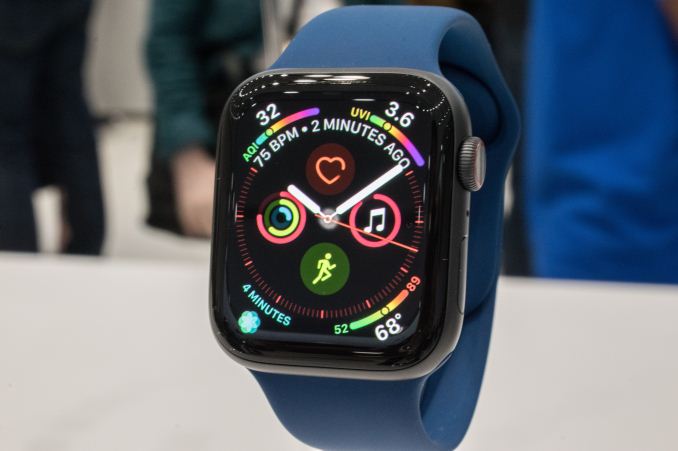
Today alongside the new iPhone XS, XS Max and the XR, Apple first introduced the new Apple Watch Series 4. The fourth generation of the watch sees a major revamp in its specifications and the most visible external design change to date.
Inside the new Apple Watch 4, we see Apple transition to a new SiP (Silicon in Package) design with a new S4 SoC containing for the first time a custom Apple designed CPU and GPU. We don’t have much information on the specifications here other than the new dual-CPU is 64-bit capable and is promised to perform twice as fast as it’s predecessors – which used Arm’s Cortex A7.
It’s to be noted that the 64-bit part of the new CPU might not be as clear as one might think, as there’s been some evidence (Credit @KhaosT) that the Watch might be running in ARM64_32 mode, which would be a 32-bit submode of AArch64 that allows for 32-bit pointers while retaining the ISA advantages of AArch64. Such a mode would be most optimal for a low-memory device such as smartwatch.
Prior generations of the Apple watch used a variation of an Imagination SGX core. For the S4 again Apple claims it’s a new custom GPU – again we don’t have any details here other than what Apple talked about in the presentation.
Finally the new S4 SiP includes new accelerometer and gyroscope functionality that has 2x the dynamic range in terms of measurable values, as well as able to sample data at 8x the speed. What this allows Apple to do is to collect a lot more data at higher accuracy and try to determine the scenario that you’re in. For example Apple claims the new watch is able to discern between falling, tripping and slipping just based on the movements that the person makes – whose detection is now enables by the new hardware sensor capabilities.
The new watch comes in 40 and 44mm sizes, and is fully compatible with prior generation Watch bands.
The core new characteristic of the new watch is the larger screen which now achieves a higher screen-to-body ratio on the watch. This is actually a pretty great improvement as the new screen feels a lot more pronounced.
To emphasize the new screen, Apple provides new watch faces with configurable information. Here the new watch allows for up to 8 complications which are at the disposal of the user. There’s also several new animated wallpapers available – these are pre-recorded videos that just play back on the watch face.
The new watch has also lost some of its thickness as it’s now 10.7mm versus the series 3’s 11.4mm. Here I’m still hoping one day we can see even thinner models, as it’s my personal least favourite aspect of smartwatches in general. Even though its thickness got reduced and it offers more performance and features, the new watch is said to maintain the same battery life longevity as its predecessors.
The sides of the watch have also changed quite a bit. On the left side we now have a larger speaker grill; Apple promises the new speaker to be a lot louder and surprisingly so for a watch. Unfortunately during the loud hands-on this was quite hard to evaluate.
On the right side we see the microphone being relocated between the button and the crown dial. The reasoning here is to reduce echo effects from the new more powerful speaker. The crown has been improved and now gives haptic feedback, trying to mimick the “clicking wheel” feel such as in more mechanical dials, or more aptly, the clicking of a mouse wheel when you scroll with it. The haptics here are enabled not by the crown itself, but by a vibration motor inside the watch.
On the back of the watch we don’t see much visible changes, however we now find a new improved optical heartrate sensor which is able to detect the heart rhythm.
What’s actually the most interesting in terms of the health monitoring capabilities of the new watch is that it actually includes for the first time ever a ECG (electrocardiogram) functionality in an over the counter consumer device. Here all you have to do while wearing the watch is to touch the crown – which serves as an anode and closes the loop created across your arms and heart.
Apple was very proud to be the first consumer device to enable this and had even received approval by the US FDA. It’s to be noted that this will beg some questions on how the feature will be implemented in other regions, as using and advertising such medical monitoring features might be disallowed if you don’t have regulatory approval.
Apple definitely is leading the smartwatch sector by a significant margin, and the company was even keen to point out that the Apple Watch is the most popular watch overall as well (Though that’s just because there’s no one dominating classic watch in a similar position).
The new Apple watch with GPS is available for $399 and the LTE variant comes in at $499 and are both available starting September 17th, with preorders starting this Friday the 14th. Overall I found the new Apple Watch 4 a lot more attractive than its predecessors – though it’s still a quite steep price point.


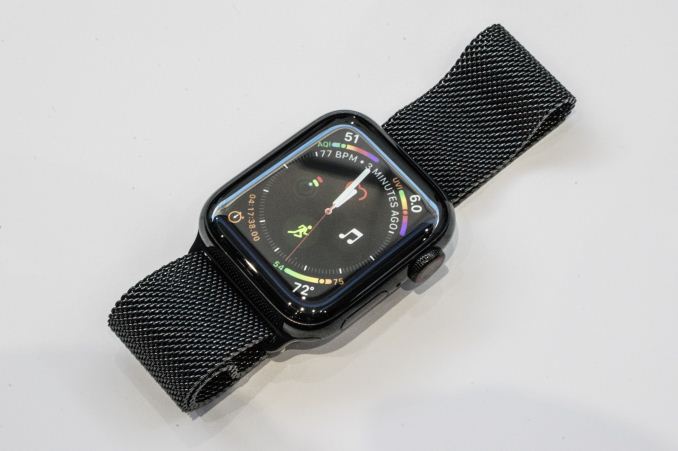
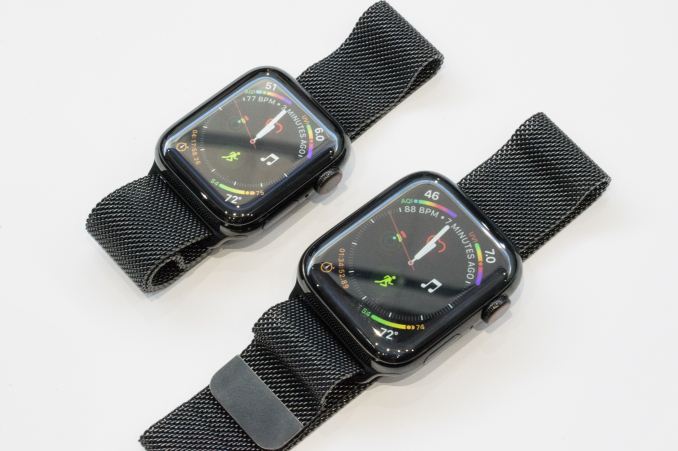
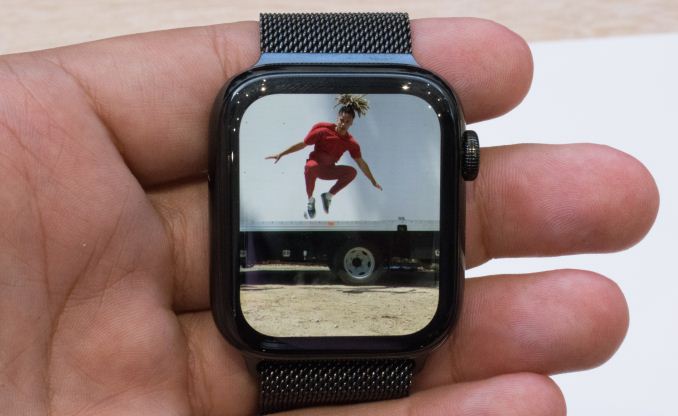
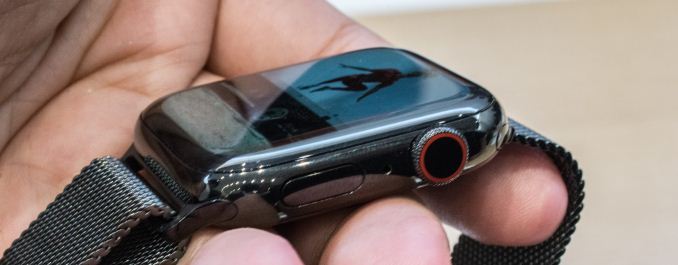









88 Comments
View All Comments
V900 - Thursday, September 13, 2018 - link
Doubt it. That process is prob too expensive for Apples taste considering it’s a 400$ device and how much they like their margins.name99 - Thursday, September 13, 2018 - link
It's unclear. 7nm IS the obvious choice, because the obvious core (for reasons I've already given) is the A12's little core.(Likewise GPU as one of the A12's 4 GPU cores? But even that seems way over powered; so that run at 1/4 frequency, or maybe there is a natural way to split one of those GPU cores into a quarter?)
But there are other issues. Power matters more than performance, so you may want to "recompile" the core and the GPU to use low power transistors everywhere; and if you're doing that, maybe recompile to a different process? There's also the issue that it would be natural for Apple to maintain relationships with all three foundries, just to have backups in place. So eg they might fabricate the wireless chips (W1, W2, now W3) on GloFo, and the watch chips on Samsung?
(W3 seems to bring BT 5 to the mix, W2 was BT 4.2, though had better WiFi than W1; All are still only 2.4GHz.)
PeachNCream - Thursday, September 13, 2018 - link
I'd like Apple to ditch the motion sensors and the health monitoring stuff in order to make room for a larger battery. I think they'd be more useful as replacements for cheap flip phones by taking over basic calling and texting rather than doing whatever invasive health crap they're doing now. Just let me make phone calls and check my gmail from the stupid thing without carrying around a nowadays huge cellphone.V900 - Thursday, September 13, 2018 - link
Get an iPhone SE: Small, snappy and good battery life.Phones have gotten too big, and Apple is helping making that problem even worse.
Hxx - Thursday, September 13, 2018 - link
too bad it doesn't even look like a watch...its freaking rectangular. i wish they would make a actual watch but with "smart" capabilities. It can't be that hard. It would be an instabuy for me.V900 - Thursday, September 13, 2018 - link
As an owner of over a dozen watches through the years, Ibcan confirm that the Apple Watch does indeed look like... A watch.This is a watch with “smart” capabilities, what exactly do you have in mind.
name99 - Thursday, September 13, 2018 - link
"It’s to be noted that the 64-bit part of the new CPU might not be as clear as one might think"We know a lot more than this.
The Watch is NOT running a 32-bit "mode", this is not a hardware issue it is a compiler issue. The compiler model is what you might call a small model rather than a large model; ILP32. Pointers are stored as 32-bit (so using less RAM), but the registers are 64 bit, the instructions are 64-bit. Just like ILP32 on x86.
Also we know that the watch is executing what Apple calls the ARM64e instruction set, which is a subset (or perhaps the whole) of ARMv8.3. The most significant aspect of this is PAC, pointer authentication. This is a way to "sign" pointers (procPtrs and return addresses) so that it's harder to overwrite them (so, for example, even if you discover a stack overflow bug, and use it to overwrite a return address, your return address will not be signed properly and so will generate a CPU exception). We know that A12 also has PAC, and iOS12 is using it; we don't know if watchOS is using it. It's possible the PAC instructions for the S4 are NOPs, and the importance of the ARM64e is in some of the other instructions offered (like NEON instructions for complex multiply, and a faster wat to test for exact conversion of an FP to int --- relevant to JS).
But an interesting consequence of the CPU being 64e is that it means (presumably) that it's NOT just a repurposed Zephyr (A10 small core) or Mistral (A11 small core). Apple likes to reuse IP a lot; so the obvious guess is that it's the A12 small core --- maybe they were confident enough in schedule that they were willing to tie the two projects together?
Integr8d - Monday, September 17, 2018 - link
"What’s actually the most interesting in terms of the health monitoring capabilities of the new watch is that it actually includes for the first time ever a ECG (electrocardiogram) functionality in an over the counter consumer device."How is that different than the Polar heart rate chest straps that athletes have been wearing for years? Unless I'm mistaken, they're both measuring electrical impulses.